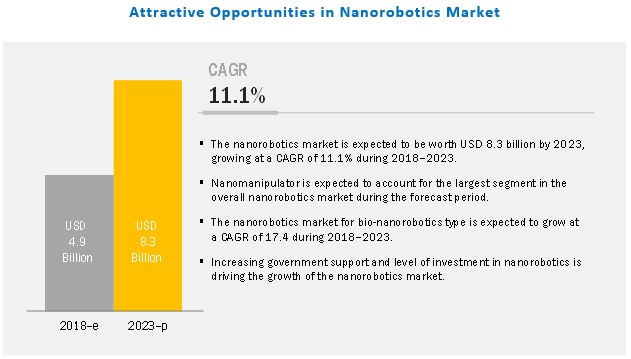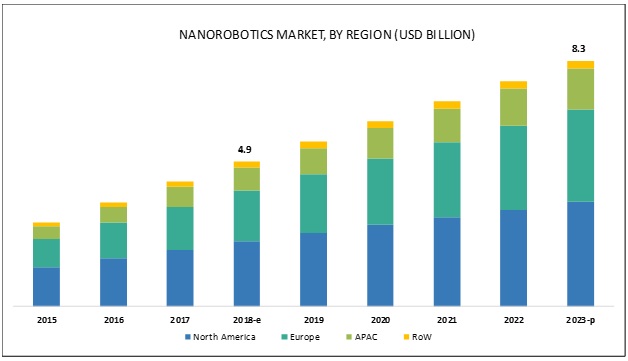According to the new market research report on the "Nanorobotics Market by Type (Nanomanipulator (Electron Microscope and Scanning Probe Microscope), Bio-Nanorobotics, Magnetically Guided, and Bacteria-Based), Application (Nanomedicine, Biomedical, and Mechanical), and Geography - Global Forecast to 2023", published by MarketsandMarkets™, the Nanorobotics Market is estimated to grow from USD 4.9 billion in 2018 to USD 8.3 billion by 2023, at a CAGR of 11.1%.
The market is mainly driven by factors such as increasing government support and level of investment in nanorobotics, growing advancements in molecular robots, and rising focus on nanotechnology and regenerative medicine.
Ask for PDF Brochure:
https://www.marketsandmarkets.com/pdfdownloadNew.asp?id=23476797

Nanorobotics Market for magnetically guided nanorobotics to grow at highest CAGR during forecast period
The nanorobotics market for magnetically guided type is expected to grow at the highest CAGR during the forecast period. This is attributed to the ease of use of magnetically guided nanorobotics systems as compared with other nanorobotics types. Globally, several companies and research institutes have developed magnetic manipulation system that uses electromagnetic coils to wirelessly guide nanorobots in several nanorobotics applications. The market for bio-nanorobotics is expected to grow at the second-highest CAGR during the forecast period.
Browse in-depth TOC on "Nanorobotics Market"
33 – Tables
31 – Figures
113 – Pages
Nanomedicine application to hold largest share of nanorobotics market during forecast period
Nanorobotics is widely used in nanomedicine owning to its healthcare characteristics. Nanomedicine is expected to hold the largest share throughout the forecast period of the overall nanorobotics market, by application. The large share of this application attributes to the large level of commercialization in the healthcare sector for drug delivery, biomaterial, in vivo imaging, in vitro diagnostic, active implants, and drug therapy. The market for biomedical applications accounted for the second-largest share of the overall nanorobotics market, by application, in 2017.
Americas to remain major consumer of nanorobotics during forecast period

The Americas is expected to be a major consumer for nanorobotics solutions during the forecast period. The growth in this market is mainly driven by the favorable government scenario for nanorobotics research and focus on nanotechnology and regenerative medicine. Also, the large share of this region can also be attributed to the highly developed healthcare system and the presence of a large number of nanorobotics players.
Get 10% Free Customization on this Report:
https://www.marketsandmarkets.com/requestCustomizationNew.asp?id=23476797
The report profiles the most promising players in the market. The market is highly dynamic because of the presence of a significant number of big and small players operating in it. Key players in the market are Ginkgo Bioworks (US), Imina Technologies (Switzerland), Thermo Fisher Scientific (US), Klocke Nanotechnik (Germany), Oxford Instruments (UK), Kliendiek Nanotechnik (Germany), Bruker (US), JEOL (Japan), Toronto Nano Instrumentation (Canada), EV Group (Austria), Xidex (US), Synthace (Germany), Park Systems (South Korea), Smaract (Germany), Nanonics Imaging (Israel), Novascan Technologies (US), Angstrom Advanced (US), Hummingbird Scientific (US), NT-MDT Spectrum Instruments (SI) (Russia), and WITec (Germany).